The Impact of Emotional Intelligence on Academic Achievement: A Review
VerifiedAdded on 2020/05/28
|12
|2598
|42
Literature Review
AI Summary
This literature review investigates the relationship between emotional intelligence (EI) and academic achievement. It begins by defining EI and exploring the Mayer and Salovey Model of Emotional Intelligence (PUUM model), which includes perception, using emotions, understanding emotions, and managing emotions. The review then delves into factors that explain EI, such as self-awareness (including emotional self-awareness and self-confidence) and self-management (including self-control, conscientiousness, adaptability, and initiative). Furthermore, the review examines how academic achievement is measured, specifically considering time to completion and productive performance reports. Finally, the review discusses the impact of EI on academic success, highlighting how it helps students identify requirements, boost communication skills, and enhance brain activities. The conclusion emphasizes the importance of EI in facilitating academic achievement, summarizing key findings and the implications of EI on student success.
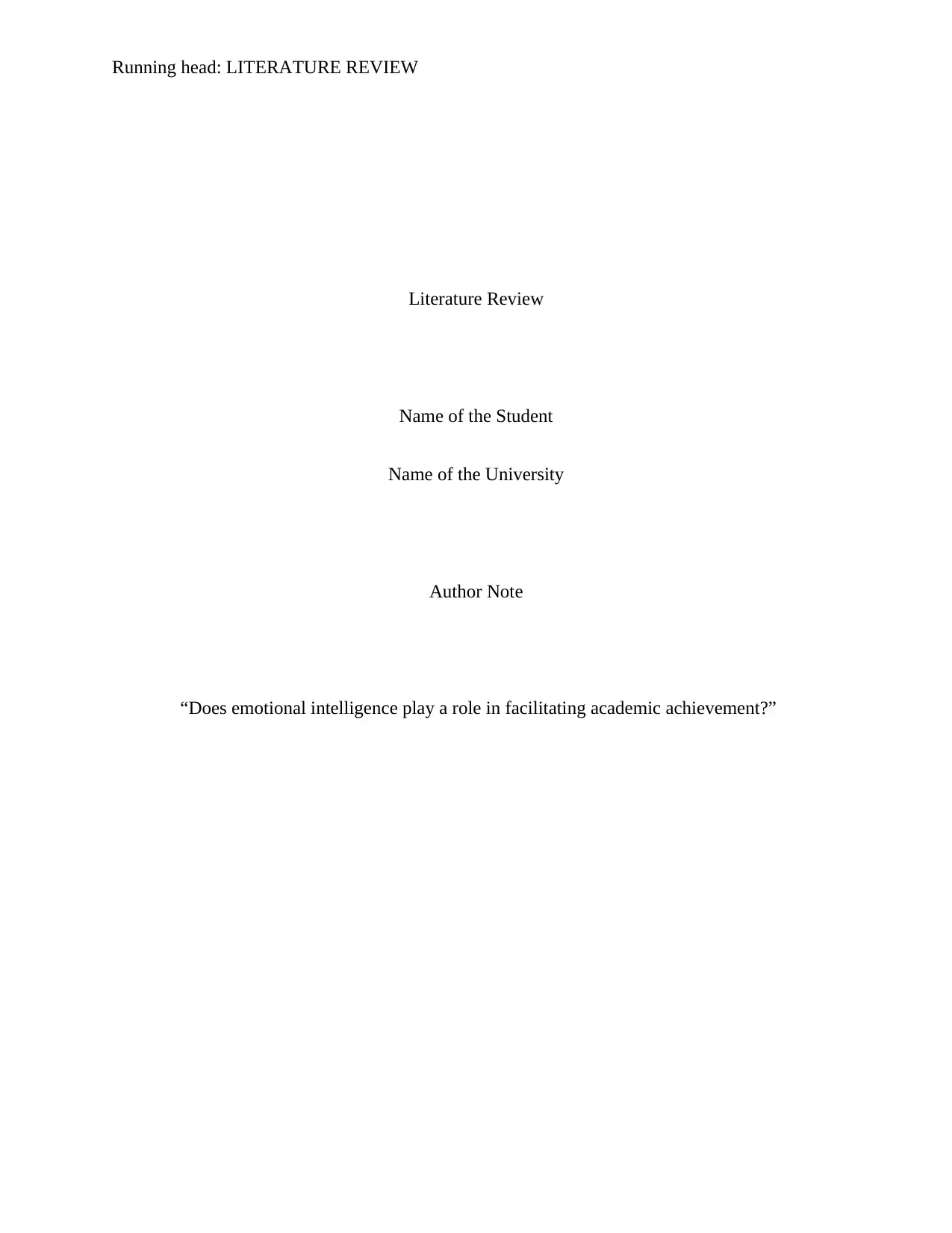
Running head: LITERATURE REVIEW
Literature Review
Name of the Student
Name of the University
Author Note
“Does emotional intelligence play a role in facilitating academic achievement?”
Literature Review
Name of the Student
Name of the University
Author Note
“Does emotional intelligence play a role in facilitating academic achievement?”
Paraphrase This Document
Need a fresh take? Get an instant paraphrase of this document with our AI Paraphraser
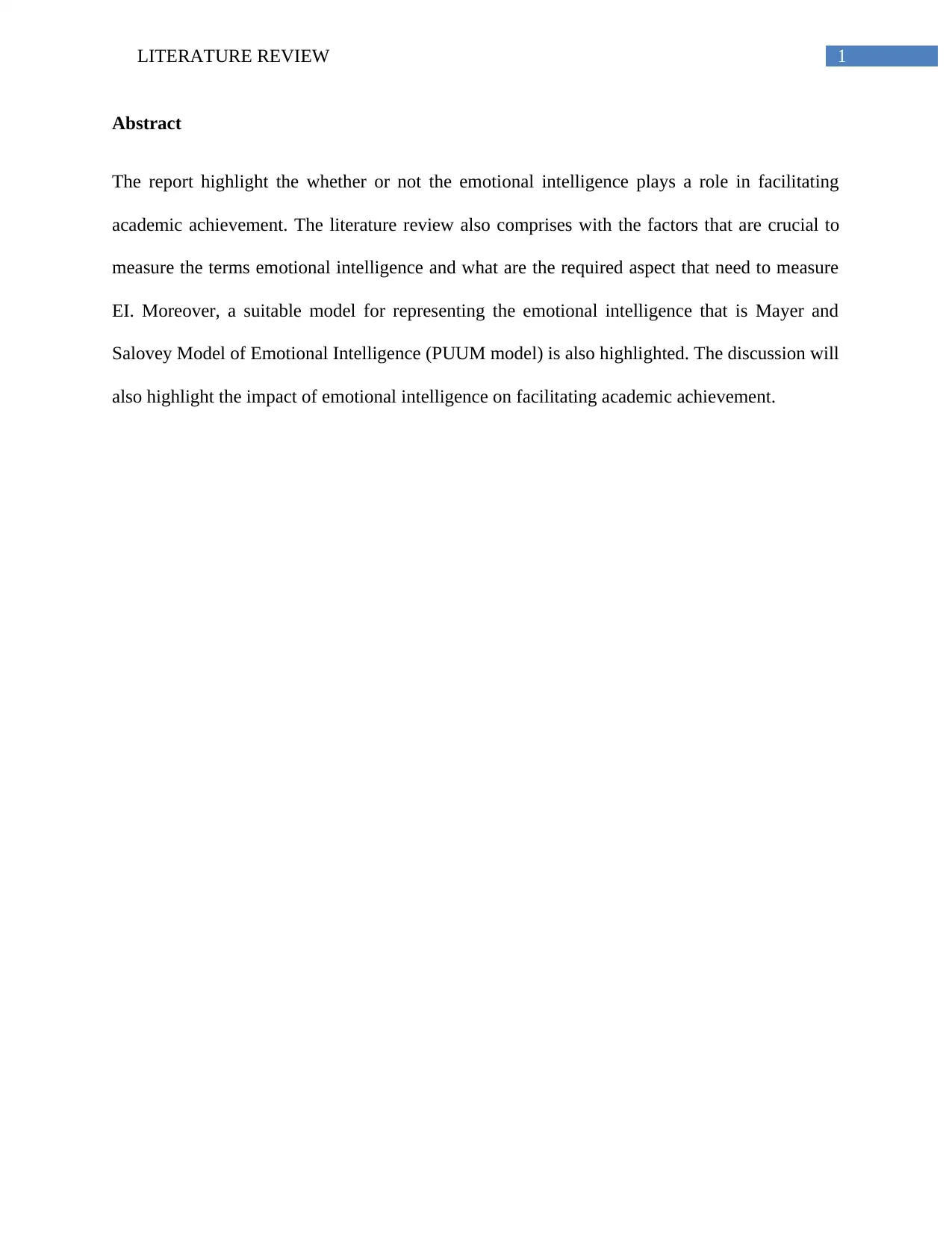
1LITERATURE REVIEW
Abstract
The report highlight the whether or not the emotional intelligence plays a role in facilitating
academic achievement. The literature review also comprises with the factors that are crucial to
measure the terms emotional intelligence and what are the required aspect that need to measure
EI. Moreover, a suitable model for representing the emotional intelligence that is Mayer and
Salovey Model of Emotional Intelligence (PUUM model) is also highlighted. The discussion will
also highlight the impact of emotional intelligence on facilitating academic achievement.
Abstract
The report highlight the whether or not the emotional intelligence plays a role in facilitating
academic achievement. The literature review also comprises with the factors that are crucial to
measure the terms emotional intelligence and what are the required aspect that need to measure
EI. Moreover, a suitable model for representing the emotional intelligence that is Mayer and
Salovey Model of Emotional Intelligence (PUUM model) is also highlighted. The discussion will
also highlight the impact of emotional intelligence on facilitating academic achievement.
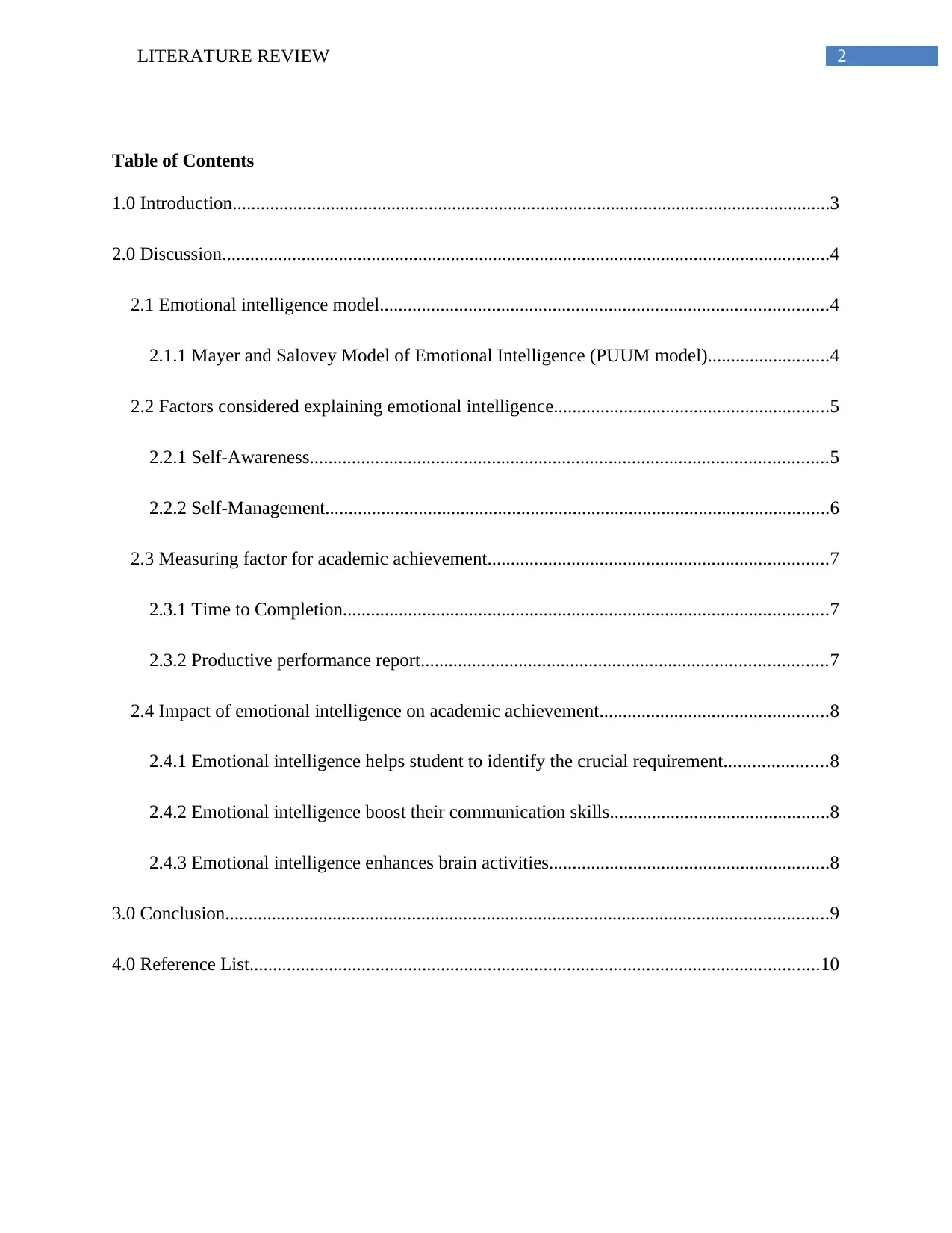
2LITERATURE REVIEW
Table of Contents
1.0 Introduction................................................................................................................................3
2.0 Discussion..................................................................................................................................4
2.1 Emotional intelligence model................................................................................................4
2.1.1 Mayer and Salovey Model of Emotional Intelligence (PUUM model)..........................4
2.2 Factors considered explaining emotional intelligence...........................................................5
2.2.1 Self-Awareness...............................................................................................................5
2.2.2 Self-Management............................................................................................................6
2.3 Measuring factor for academic achievement.........................................................................7
2.3.1 Time to Completion........................................................................................................7
2.3.2 Productive performance report.......................................................................................7
2.4 Impact of emotional intelligence on academic achievement.................................................8
2.4.1 Emotional intelligence helps student to identify the crucial requirement......................8
2.4.2 Emotional intelligence boost their communication skills...............................................8
2.4.3 Emotional intelligence enhances brain activities............................................................8
3.0 Conclusion.................................................................................................................................9
4.0 Reference List..........................................................................................................................10
Table of Contents
1.0 Introduction................................................................................................................................3
2.0 Discussion..................................................................................................................................4
2.1 Emotional intelligence model................................................................................................4
2.1.1 Mayer and Salovey Model of Emotional Intelligence (PUUM model)..........................4
2.2 Factors considered explaining emotional intelligence...........................................................5
2.2.1 Self-Awareness...............................................................................................................5
2.2.2 Self-Management............................................................................................................6
2.3 Measuring factor for academic achievement.........................................................................7
2.3.1 Time to Completion........................................................................................................7
2.3.2 Productive performance report.......................................................................................7
2.4 Impact of emotional intelligence on academic achievement.................................................8
2.4.1 Emotional intelligence helps student to identify the crucial requirement......................8
2.4.2 Emotional intelligence boost their communication skills...............................................8
2.4.3 Emotional intelligence enhances brain activities............................................................8
3.0 Conclusion.................................................................................................................................9
4.0 Reference List..........................................................................................................................10
⊘ This is a preview!⊘
Do you want full access?
Subscribe today to unlock all pages.

Trusted by 1+ million students worldwide
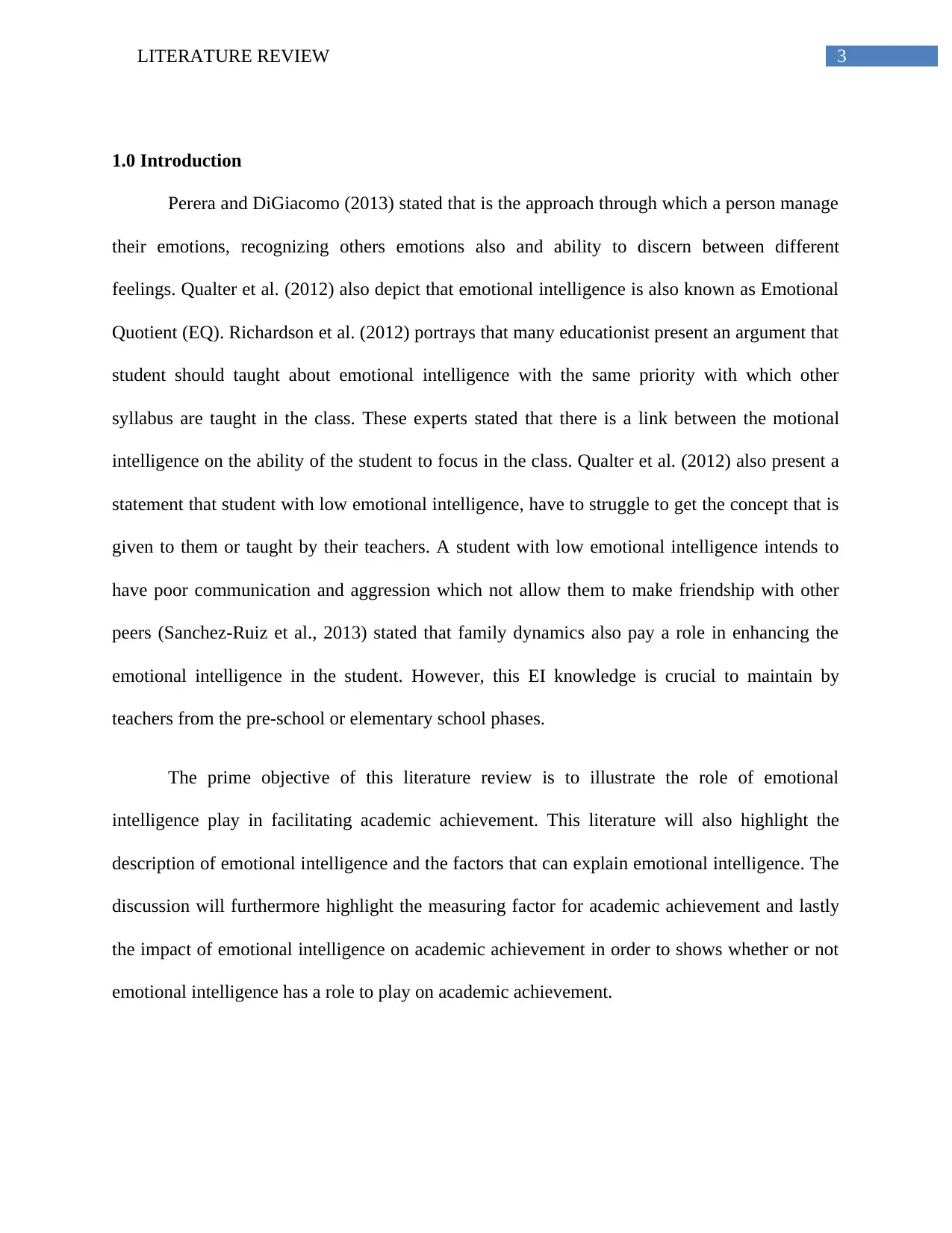
3LITERATURE REVIEW
1.0 Introduction
Perera and DiGiacomo (2013) stated that is the approach through which a person manage
their emotions, recognizing others emotions also and ability to discern between different
feelings. Qualter et al. (2012) also depict that emotional intelligence is also known as Emotional
Quotient (EQ). Richardson et al. (2012) portrays that many educationist present an argument that
student should taught about emotional intelligence with the same priority with which other
syllabus are taught in the class. These experts stated that there is a link between the motional
intelligence on the ability of the student to focus in the class. Qualter et al. (2012) also present a
statement that student with low emotional intelligence, have to struggle to get the concept that is
given to them or taught by their teachers. A student with low emotional intelligence intends to
have poor communication and aggression which not allow them to make friendship with other
peers (Sanchez-Ruiz et al., 2013) stated that family dynamics also pay a role in enhancing the
emotional intelligence in the student. However, this EI knowledge is crucial to maintain by
teachers from the pre-school or elementary school phases.
The prime objective of this literature review is to illustrate the role of emotional
intelligence play in facilitating academic achievement. This literature will also highlight the
description of emotional intelligence and the factors that can explain emotional intelligence. The
discussion will furthermore highlight the measuring factor for academic achievement and lastly
the impact of emotional intelligence on academic achievement in order to shows whether or not
emotional intelligence has a role to play on academic achievement.
1.0 Introduction
Perera and DiGiacomo (2013) stated that is the approach through which a person manage
their emotions, recognizing others emotions also and ability to discern between different
feelings. Qualter et al. (2012) also depict that emotional intelligence is also known as Emotional
Quotient (EQ). Richardson et al. (2012) portrays that many educationist present an argument that
student should taught about emotional intelligence with the same priority with which other
syllabus are taught in the class. These experts stated that there is a link between the motional
intelligence on the ability of the student to focus in the class. Qualter et al. (2012) also present a
statement that student with low emotional intelligence, have to struggle to get the concept that is
given to them or taught by their teachers. A student with low emotional intelligence intends to
have poor communication and aggression which not allow them to make friendship with other
peers (Sanchez-Ruiz et al., 2013) stated that family dynamics also pay a role in enhancing the
emotional intelligence in the student. However, this EI knowledge is crucial to maintain by
teachers from the pre-school or elementary school phases.
The prime objective of this literature review is to illustrate the role of emotional
intelligence play in facilitating academic achievement. This literature will also highlight the
description of emotional intelligence and the factors that can explain emotional intelligence. The
discussion will furthermore highlight the measuring factor for academic achievement and lastly
the impact of emotional intelligence on academic achievement in order to shows whether or not
emotional intelligence has a role to play on academic achievement.
Paraphrase This Document
Need a fresh take? Get an instant paraphrase of this document with our AI Paraphraser
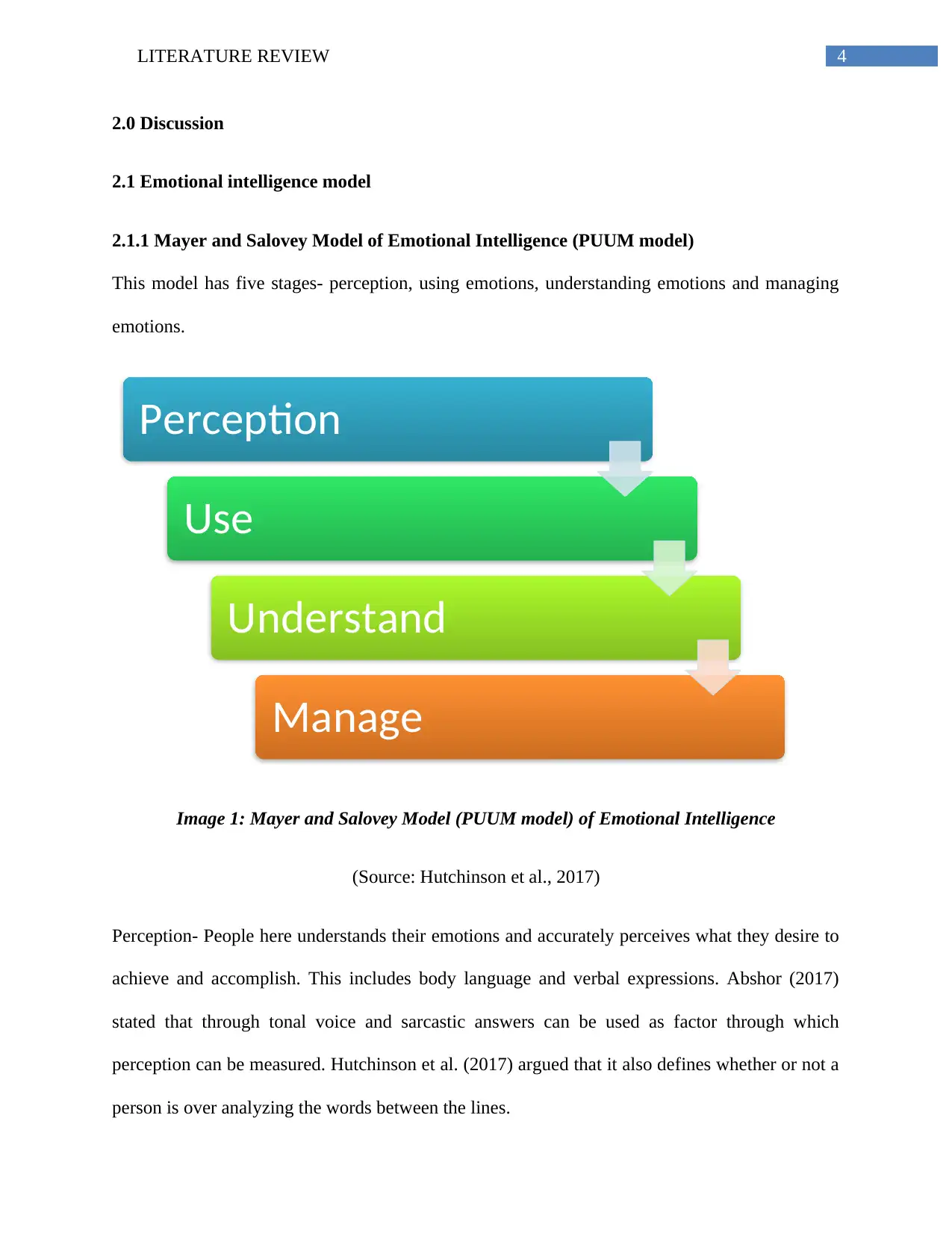
4LITERATURE REVIEW
2.0 Discussion
2.1 Emotional intelligence model
2.1.1 Mayer and Salovey Model of Emotional Intelligence (PUUM model)
This model has five stages- perception, using emotions, understanding emotions and managing
emotions.
Image 1: Mayer and Salovey Model (PUUM model) of Emotional Intelligence
(Source: Hutchinson et al., 2017)
Perception- People here understands their emotions and accurately perceives what they desire to
achieve and accomplish. This includes body language and verbal expressions. Abshor (2017)
stated that through tonal voice and sarcastic answers can be used as factor through which
perception can be measured. Hutchinson et al. (2017) argued that it also defines whether or not a
person is over analyzing the words between the lines.
Perception
Use
Understand
Manage
2.0 Discussion
2.1 Emotional intelligence model
2.1.1 Mayer and Salovey Model of Emotional Intelligence (PUUM model)
This model has five stages- perception, using emotions, understanding emotions and managing
emotions.
Image 1: Mayer and Salovey Model (PUUM model) of Emotional Intelligence
(Source: Hutchinson et al., 2017)
Perception- People here understands their emotions and accurately perceives what they desire to
achieve and accomplish. This includes body language and verbal expressions. Abshor (2017)
stated that through tonal voice and sarcastic answers can be used as factor through which
perception can be measured. Hutchinson et al. (2017) argued that it also defines whether or not a
person is over analyzing the words between the lines.
Perception
Use
Understand
Manage
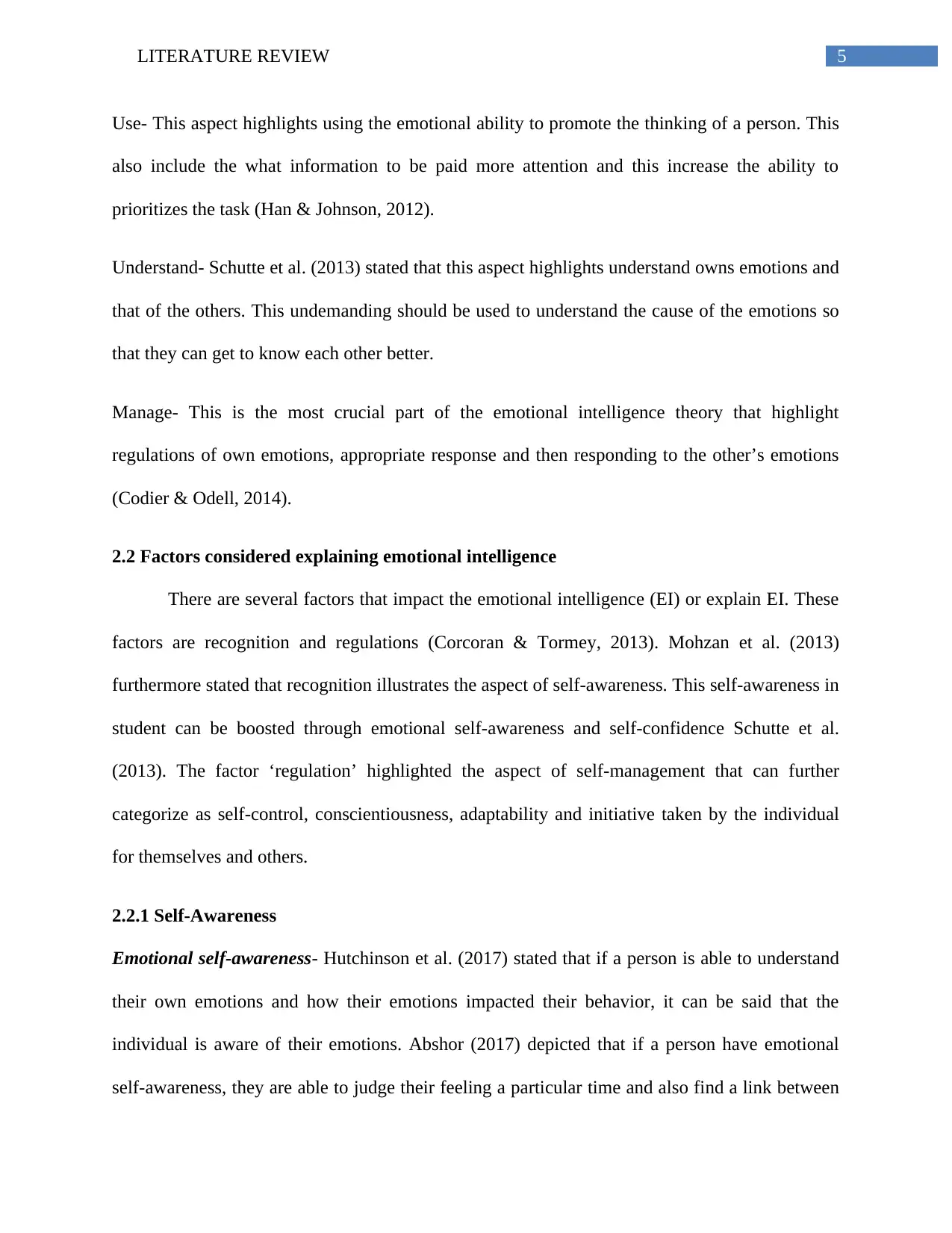
5LITERATURE REVIEW
Use- This aspect highlights using the emotional ability to promote the thinking of a person. This
also include the what information to be paid more attention and this increase the ability to
prioritizes the task (Han & Johnson, 2012).
Understand- Schutte et al. (2013) stated that this aspect highlights understand owns emotions and
that of the others. This undemanding should be used to understand the cause of the emotions so
that they can get to know each other better.
Manage- This is the most crucial part of the emotional intelligence theory that highlight
regulations of own emotions, appropriate response and then responding to the other’s emotions
(Codier & Odell, 2014).
2.2 Factors considered explaining emotional intelligence
There are several factors that impact the emotional intelligence (EI) or explain EI. These
factors are recognition and regulations (Corcoran & Tormey, 2013). Mohzan et al. (2013)
furthermore stated that recognition illustrates the aspect of self-awareness. This self-awareness in
student can be boosted through emotional self-awareness and self-confidence Schutte et al.
(2013). The factor ‘regulation’ highlighted the aspect of self-management that can further
categorize as self-control, conscientiousness, adaptability and initiative taken by the individual
for themselves and others.
2.2.1 Self-Awareness
Emotional self-awareness- Hutchinson et al. (2017) stated that if a person is able to understand
their own emotions and how their emotions impacted their behavior, it can be said that the
individual is aware of their emotions. Abshor (2017) depicted that if a person have emotional
self-awareness, they are able to judge their feeling a particular time and also find a link between
Use- This aspect highlights using the emotional ability to promote the thinking of a person. This
also include the what information to be paid more attention and this increase the ability to
prioritizes the task (Han & Johnson, 2012).
Understand- Schutte et al. (2013) stated that this aspect highlights understand owns emotions and
that of the others. This undemanding should be used to understand the cause of the emotions so
that they can get to know each other better.
Manage- This is the most crucial part of the emotional intelligence theory that highlight
regulations of own emotions, appropriate response and then responding to the other’s emotions
(Codier & Odell, 2014).
2.2 Factors considered explaining emotional intelligence
There are several factors that impact the emotional intelligence (EI) or explain EI. These
factors are recognition and regulations (Corcoran & Tormey, 2013). Mohzan et al. (2013)
furthermore stated that recognition illustrates the aspect of self-awareness. This self-awareness in
student can be boosted through emotional self-awareness and self-confidence Schutte et al.
(2013). The factor ‘regulation’ highlighted the aspect of self-management that can further
categorize as self-control, conscientiousness, adaptability and initiative taken by the individual
for themselves and others.
2.2.1 Self-Awareness
Emotional self-awareness- Hutchinson et al. (2017) stated that if a person is able to understand
their own emotions and how their emotions impacted their behavior, it can be said that the
individual is aware of their emotions. Abshor (2017) depicted that if a person have emotional
self-awareness, they are able to judge their feeling a particular time and also find a link between
⊘ This is a preview!⊘
Do you want full access?
Subscribe today to unlock all pages.

Trusted by 1+ million students worldwide
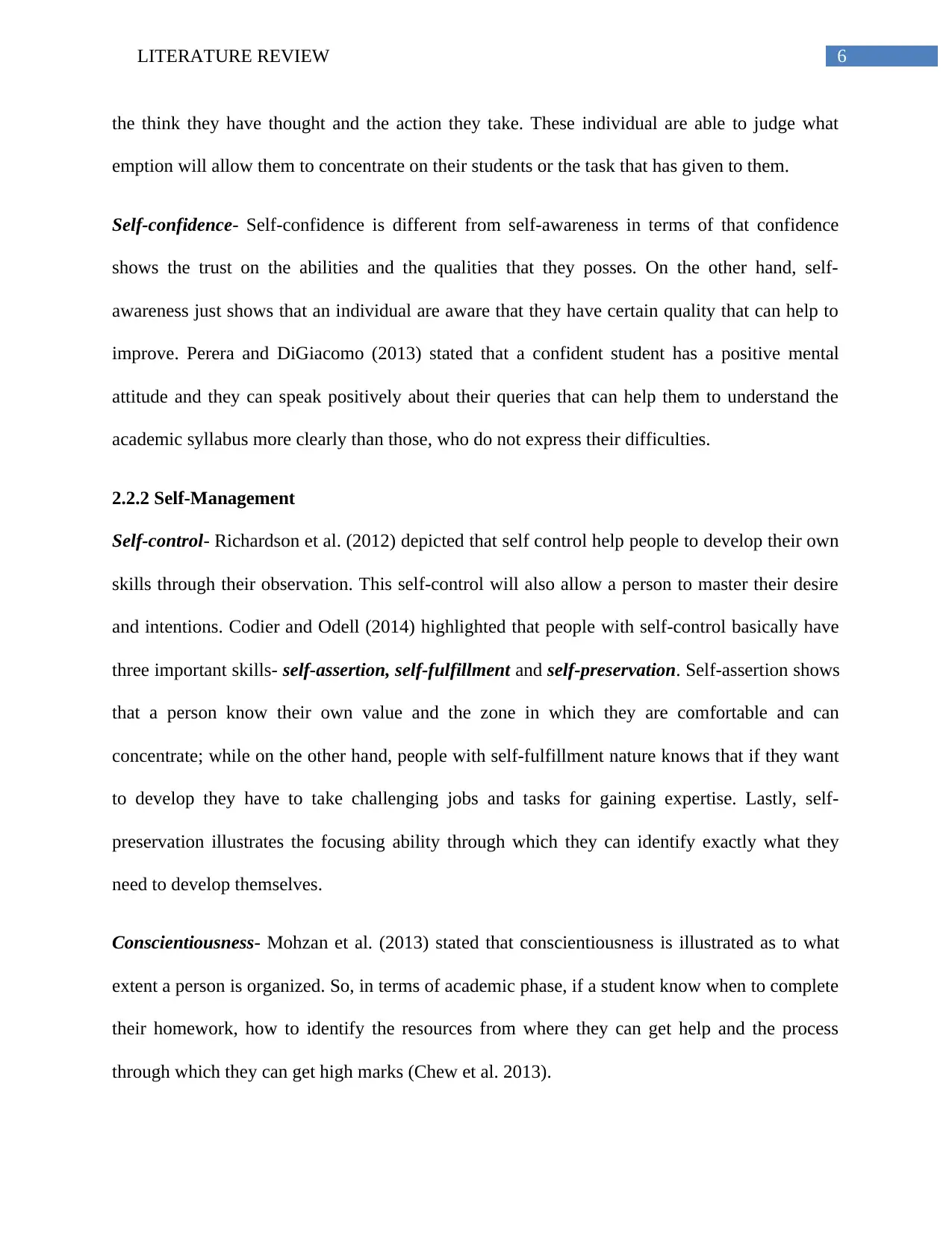
6LITERATURE REVIEW
the think they have thought and the action they take. These individual are able to judge what
emption will allow them to concentrate on their students or the task that has given to them.
Self-confidence- Self-confidence is different from self-awareness in terms of that confidence
shows the trust on the abilities and the qualities that they posses. On the other hand, self-
awareness just shows that an individual are aware that they have certain quality that can help to
improve. Perera and DiGiacomo (2013) stated that a confident student has a positive mental
attitude and they can speak positively about their queries that can help them to understand the
academic syllabus more clearly than those, who do not express their difficulties.
2.2.2 Self-Management
Self-control- Richardson et al. (2012) depicted that self control help people to develop their own
skills through their observation. This self-control will also allow a person to master their desire
and intentions. Codier and Odell (2014) highlighted that people with self-control basically have
three important skills- self-assertion, self-fulfillment and self-preservation. Self-assertion shows
that a person know their own value and the zone in which they are comfortable and can
concentrate; while on the other hand, people with self-fulfillment nature knows that if they want
to develop they have to take challenging jobs and tasks for gaining expertise. Lastly, self-
preservation illustrates the focusing ability through which they can identify exactly what they
need to develop themselves.
Conscientiousness- Mohzan et al. (2013) stated that conscientiousness is illustrated as to what
extent a person is organized. So, in terms of academic phase, if a student know when to complete
their homework, how to identify the resources from where they can get help and the process
through which they can get high marks (Chew et al. 2013).
the think they have thought and the action they take. These individual are able to judge what
emption will allow them to concentrate on their students or the task that has given to them.
Self-confidence- Self-confidence is different from self-awareness in terms of that confidence
shows the trust on the abilities and the qualities that they posses. On the other hand, self-
awareness just shows that an individual are aware that they have certain quality that can help to
improve. Perera and DiGiacomo (2013) stated that a confident student has a positive mental
attitude and they can speak positively about their queries that can help them to understand the
academic syllabus more clearly than those, who do not express their difficulties.
2.2.2 Self-Management
Self-control- Richardson et al. (2012) depicted that self control help people to develop their own
skills through their observation. This self-control will also allow a person to master their desire
and intentions. Codier and Odell (2014) highlighted that people with self-control basically have
three important skills- self-assertion, self-fulfillment and self-preservation. Self-assertion shows
that a person know their own value and the zone in which they are comfortable and can
concentrate; while on the other hand, people with self-fulfillment nature knows that if they want
to develop they have to take challenging jobs and tasks for gaining expertise. Lastly, self-
preservation illustrates the focusing ability through which they can identify exactly what they
need to develop themselves.
Conscientiousness- Mohzan et al. (2013) stated that conscientiousness is illustrated as to what
extent a person is organized. So, in terms of academic phase, if a student know when to complete
their homework, how to identify the resources from where they can get help and the process
through which they can get high marks (Chew et al. 2013).
Paraphrase This Document
Need a fresh take? Get an instant paraphrase of this document with our AI Paraphraser
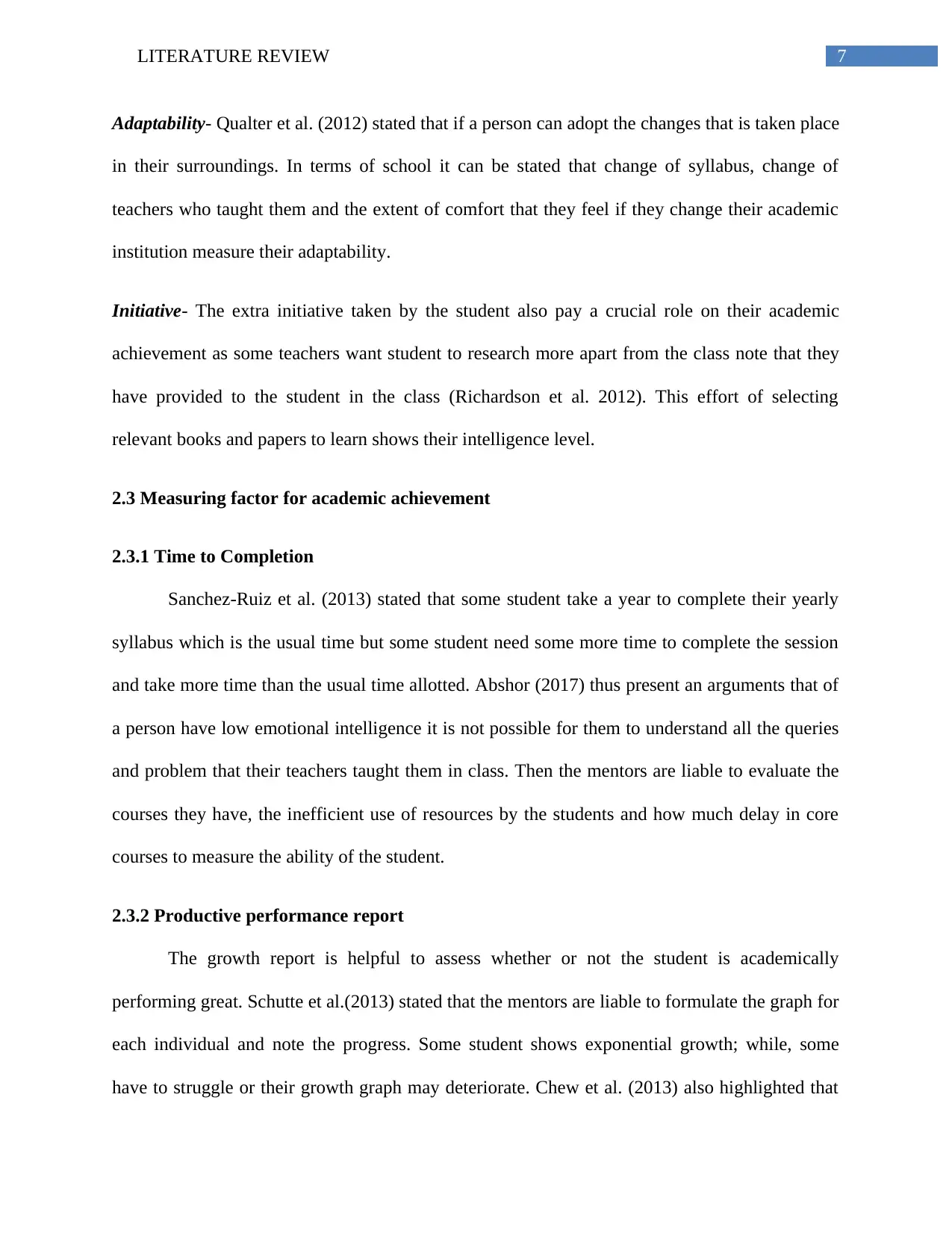
7LITERATURE REVIEW
Adaptability- Qualter et al. (2012) stated that if a person can adopt the changes that is taken place
in their surroundings. In terms of school it can be stated that change of syllabus, change of
teachers who taught them and the extent of comfort that they feel if they change their academic
institution measure their adaptability.
Initiative- The extra initiative taken by the student also pay a crucial role on their academic
achievement as some teachers want student to research more apart from the class note that they
have provided to the student in the class (Richardson et al. 2012). This effort of selecting
relevant books and papers to learn shows their intelligence level.
2.3 Measuring factor for academic achievement
2.3.1 Time to Completion
Sanchez-Ruiz et al. (2013) stated that some student take a year to complete their yearly
syllabus which is the usual time but some student need some more time to complete the session
and take more time than the usual time allotted. Abshor (2017) thus present an arguments that of
a person have low emotional intelligence it is not possible for them to understand all the queries
and problem that their teachers taught them in class. Then the mentors are liable to evaluate the
courses they have, the inefficient use of resources by the students and how much delay in core
courses to measure the ability of the student.
2.3.2 Productive performance report
The growth report is helpful to assess whether or not the student is academically
performing great. Schutte et al.(2013) stated that the mentors are liable to formulate the graph for
each individual and note the progress. Some student shows exponential growth; while, some
have to struggle or their growth graph may deteriorate. Chew et al. (2013) also highlighted that
Adaptability- Qualter et al. (2012) stated that if a person can adopt the changes that is taken place
in their surroundings. In terms of school it can be stated that change of syllabus, change of
teachers who taught them and the extent of comfort that they feel if they change their academic
institution measure their adaptability.
Initiative- The extra initiative taken by the student also pay a crucial role on their academic
achievement as some teachers want student to research more apart from the class note that they
have provided to the student in the class (Richardson et al. 2012). This effort of selecting
relevant books and papers to learn shows their intelligence level.
2.3 Measuring factor for academic achievement
2.3.1 Time to Completion
Sanchez-Ruiz et al. (2013) stated that some student take a year to complete their yearly
syllabus which is the usual time but some student need some more time to complete the session
and take more time than the usual time allotted. Abshor (2017) thus present an arguments that of
a person have low emotional intelligence it is not possible for them to understand all the queries
and problem that their teachers taught them in class. Then the mentors are liable to evaluate the
courses they have, the inefficient use of resources by the students and how much delay in core
courses to measure the ability of the student.
2.3.2 Productive performance report
The growth report is helpful to assess whether or not the student is academically
performing great. Schutte et al.(2013) stated that the mentors are liable to formulate the graph for
each individual and note the progress. Some student shows exponential growth; while, some
have to struggle or their growth graph may deteriorate. Chew et al. (2013) also highlighted that
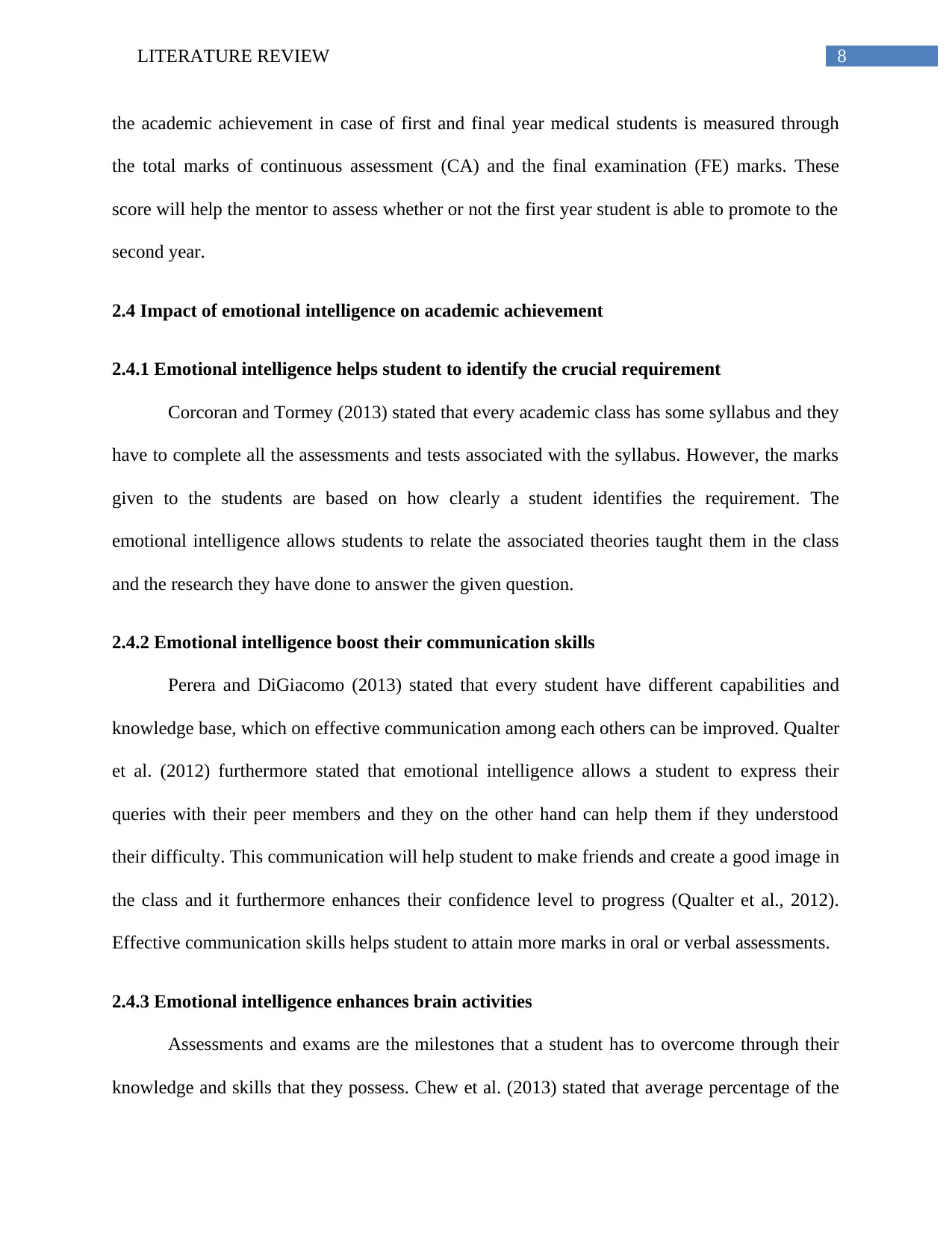
8LITERATURE REVIEW
the academic achievement in case of first and final year medical students is measured through
the total marks of continuous assessment (CA) and the final examination (FE) marks. These
score will help the mentor to assess whether or not the first year student is able to promote to the
second year.
2.4 Impact of emotional intelligence on academic achievement
2.4.1 Emotional intelligence helps student to identify the crucial requirement
Corcoran and Tormey (2013) stated that every academic class has some syllabus and they
have to complete all the assessments and tests associated with the syllabus. However, the marks
given to the students are based on how clearly a student identifies the requirement. The
emotional intelligence allows students to relate the associated theories taught them in the class
and the research they have done to answer the given question.
2.4.2 Emotional intelligence boost their communication skills
Perera and DiGiacomo (2013) stated that every student have different capabilities and
knowledge base, which on effective communication among each others can be improved. Qualter
et al. (2012) furthermore stated that emotional intelligence allows a student to express their
queries with their peer members and they on the other hand can help them if they understood
their difficulty. This communication will help student to make friends and create a good image in
the class and it furthermore enhances their confidence level to progress (Qualter et al., 2012).
Effective communication skills helps student to attain more marks in oral or verbal assessments.
2.4.3 Emotional intelligence enhances brain activities
Assessments and exams are the milestones that a student has to overcome through their
knowledge and skills that they possess. Chew et al. (2013) stated that average percentage of the
the academic achievement in case of first and final year medical students is measured through
the total marks of continuous assessment (CA) and the final examination (FE) marks. These
score will help the mentor to assess whether or not the first year student is able to promote to the
second year.
2.4 Impact of emotional intelligence on academic achievement
2.4.1 Emotional intelligence helps student to identify the crucial requirement
Corcoran and Tormey (2013) stated that every academic class has some syllabus and they
have to complete all the assessments and tests associated with the syllabus. However, the marks
given to the students are based on how clearly a student identifies the requirement. The
emotional intelligence allows students to relate the associated theories taught them in the class
and the research they have done to answer the given question.
2.4.2 Emotional intelligence boost their communication skills
Perera and DiGiacomo (2013) stated that every student have different capabilities and
knowledge base, which on effective communication among each others can be improved. Qualter
et al. (2012) furthermore stated that emotional intelligence allows a student to express their
queries with their peer members and they on the other hand can help them if they understood
their difficulty. This communication will help student to make friends and create a good image in
the class and it furthermore enhances their confidence level to progress (Qualter et al., 2012).
Effective communication skills helps student to attain more marks in oral or verbal assessments.
2.4.3 Emotional intelligence enhances brain activities
Assessments and exams are the milestones that a student has to overcome through their
knowledge and skills that they possess. Chew et al. (2013) stated that average percentage of the
⊘ This is a preview!⊘
Do you want full access?
Subscribe today to unlock all pages.

Trusted by 1+ million students worldwide
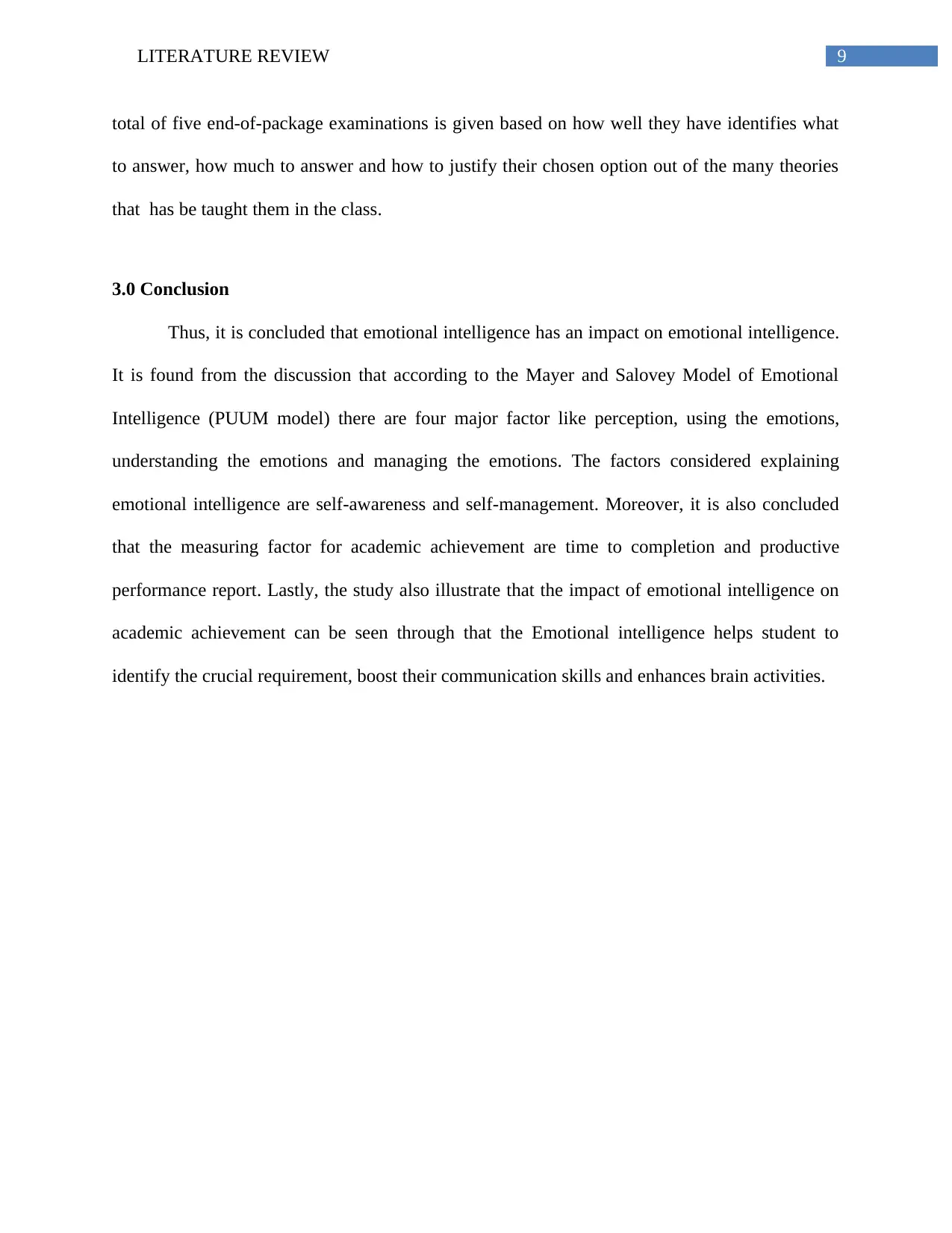
9LITERATURE REVIEW
total of five end-of-package examinations is given based on how well they have identifies what
to answer, how much to answer and how to justify their chosen option out of the many theories
that has be taught them in the class.
3.0 Conclusion
Thus, it is concluded that emotional intelligence has an impact on emotional intelligence.
It is found from the discussion that according to the Mayer and Salovey Model of Emotional
Intelligence (PUUM model) there are four major factor like perception, using the emotions,
understanding the emotions and managing the emotions. The factors considered explaining
emotional intelligence are self-awareness and self-management. Moreover, it is also concluded
that the measuring factor for academic achievement are time to completion and productive
performance report. Lastly, the study also illustrate that the impact of emotional intelligence on
academic achievement can be seen through that the Emotional intelligence helps student to
identify the crucial requirement, boost their communication skills and enhances brain activities.
total of five end-of-package examinations is given based on how well they have identifies what
to answer, how much to answer and how to justify their chosen option out of the many theories
that has be taught them in the class.
3.0 Conclusion
Thus, it is concluded that emotional intelligence has an impact on emotional intelligence.
It is found from the discussion that according to the Mayer and Salovey Model of Emotional
Intelligence (PUUM model) there are four major factor like perception, using the emotions,
understanding the emotions and managing the emotions. The factors considered explaining
emotional intelligence are self-awareness and self-management. Moreover, it is also concluded
that the measuring factor for academic achievement are time to completion and productive
performance report. Lastly, the study also illustrate that the impact of emotional intelligence on
academic achievement can be seen through that the Emotional intelligence helps student to
identify the crucial requirement, boost their communication skills and enhances brain activities.
Paraphrase This Document
Need a fresh take? Get an instant paraphrase of this document with our AI Paraphraser
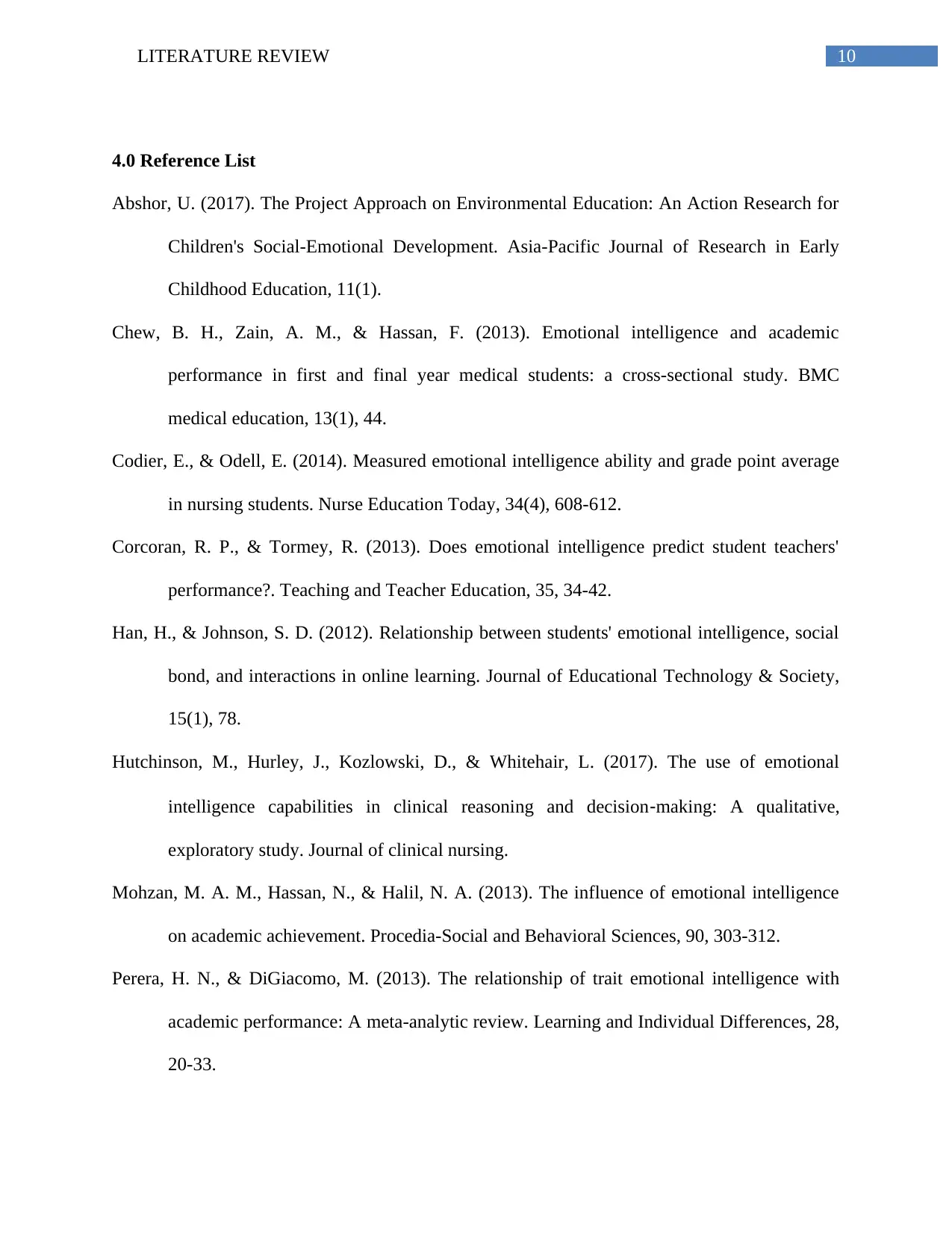
10LITERATURE REVIEW
4.0 Reference List
Abshor, U. (2017). The Project Approach on Environmental Education: An Action Research for
Children's Social-Emotional Development. Asia-Pacific Journal of Research in Early
Childhood Education, 11(1).
Chew, B. H., Zain, A. M., & Hassan, F. (2013). Emotional intelligence and academic
performance in first and final year medical students: a cross-sectional study. BMC
medical education, 13(1), 44.
Codier, E., & Odell, E. (2014). Measured emotional intelligence ability and grade point average
in nursing students. Nurse Education Today, 34(4), 608-612.
Corcoran, R. P., & Tormey, R. (2013). Does emotional intelligence predict student teachers'
performance?. Teaching and Teacher Education, 35, 34-42.
Han, H., & Johnson, S. D. (2012). Relationship between students' emotional intelligence, social
bond, and interactions in online learning. Journal of Educational Technology & Society,
15(1), 78.
Hutchinson, M., Hurley, J., Kozlowski, D., & Whitehair, L. (2017). The use of emotional
intelligence capabilities in clinical reasoning and decision‐making: A qualitative,
exploratory study. Journal of clinical nursing.
Mohzan, M. A. M., Hassan, N., & Halil, N. A. (2013). The influence of emotional intelligence
on academic achievement. Procedia-Social and Behavioral Sciences, 90, 303-312.
Perera, H. N., & DiGiacomo, M. (2013). The relationship of trait emotional intelligence with
academic performance: A meta-analytic review. Learning and Individual Differences, 28,
20-33.
4.0 Reference List
Abshor, U. (2017). The Project Approach on Environmental Education: An Action Research for
Children's Social-Emotional Development. Asia-Pacific Journal of Research in Early
Childhood Education, 11(1).
Chew, B. H., Zain, A. M., & Hassan, F. (2013). Emotional intelligence and academic
performance in first and final year medical students: a cross-sectional study. BMC
medical education, 13(1), 44.
Codier, E., & Odell, E. (2014). Measured emotional intelligence ability and grade point average
in nursing students. Nurse Education Today, 34(4), 608-612.
Corcoran, R. P., & Tormey, R. (2013). Does emotional intelligence predict student teachers'
performance?. Teaching and Teacher Education, 35, 34-42.
Han, H., & Johnson, S. D. (2012). Relationship between students' emotional intelligence, social
bond, and interactions in online learning. Journal of Educational Technology & Society,
15(1), 78.
Hutchinson, M., Hurley, J., Kozlowski, D., & Whitehair, L. (2017). The use of emotional
intelligence capabilities in clinical reasoning and decision‐making: A qualitative,
exploratory study. Journal of clinical nursing.
Mohzan, M. A. M., Hassan, N., & Halil, N. A. (2013). The influence of emotional intelligence
on academic achievement. Procedia-Social and Behavioral Sciences, 90, 303-312.
Perera, H. N., & DiGiacomo, M. (2013). The relationship of trait emotional intelligence with
academic performance: A meta-analytic review. Learning and Individual Differences, 28,
20-33.
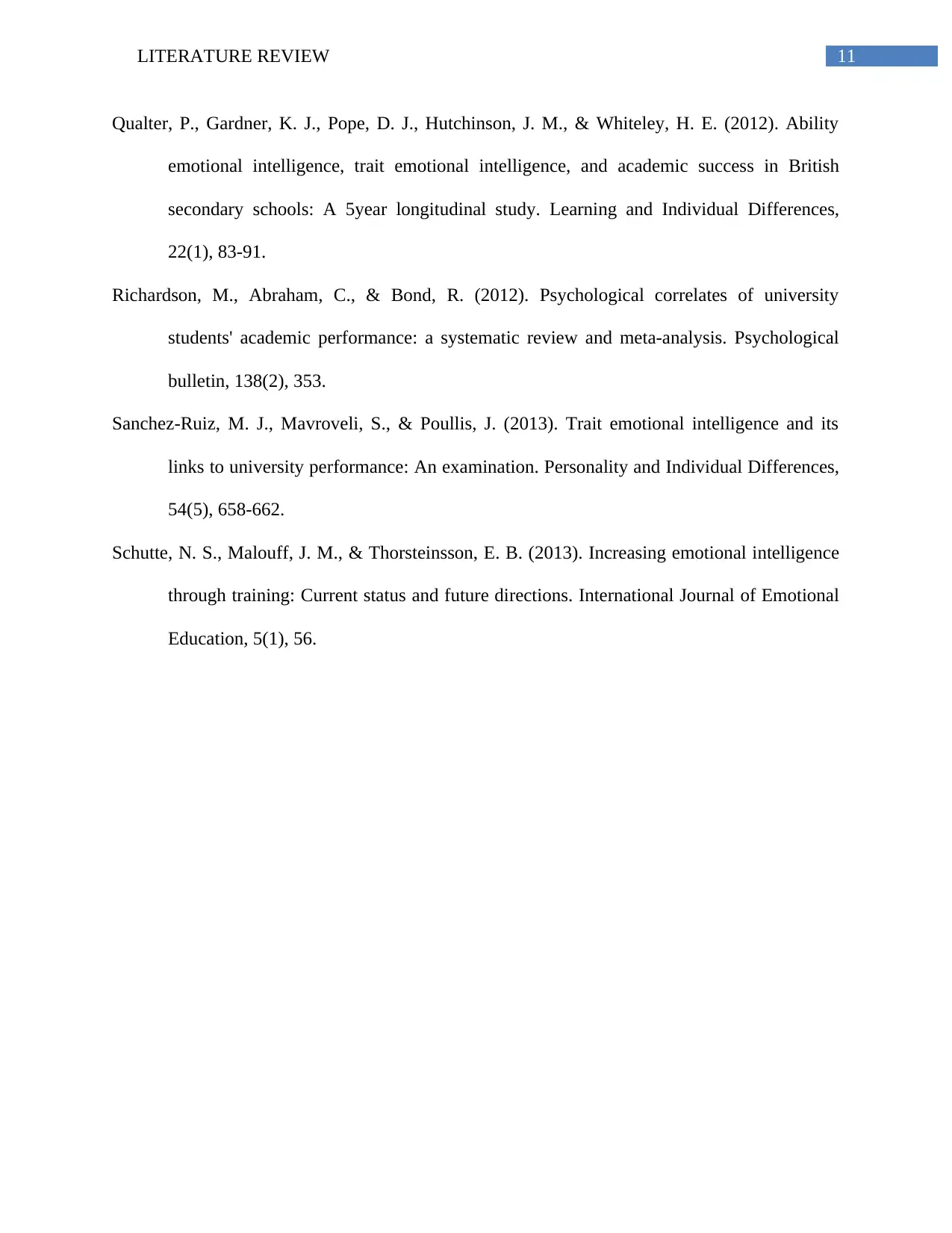
11LITERATURE REVIEW
Qualter, P., Gardner, K. J., Pope, D. J., Hutchinson, J. M., & Whiteley, H. E. (2012). Ability
emotional intelligence, trait emotional intelligence, and academic success in British
secondary schools: A 5year longitudinal study. Learning and Individual Differences,
22(1), 83-91.
Richardson, M., Abraham, C., & Bond, R. (2012). Psychological correlates of university
students' academic performance: a systematic review and meta-analysis. Psychological
bulletin, 138(2), 353.
Sanchez-Ruiz, M. J., Mavroveli, S., & Poullis, J. (2013). Trait emotional intelligence and its
links to university performance: An examination. Personality and Individual Differences,
54(5), 658-662.
Schutte, N. S., Malouff, J. M., & Thorsteinsson, E. B. (2013). Increasing emotional intelligence
through training: Current status and future directions. International Journal of Emotional
Education, 5(1), 56.
Qualter, P., Gardner, K. J., Pope, D. J., Hutchinson, J. M., & Whiteley, H. E. (2012). Ability
emotional intelligence, trait emotional intelligence, and academic success in British
secondary schools: A 5year longitudinal study. Learning and Individual Differences,
22(1), 83-91.
Richardson, M., Abraham, C., & Bond, R. (2012). Psychological correlates of university
students' academic performance: a systematic review and meta-analysis. Psychological
bulletin, 138(2), 353.
Sanchez-Ruiz, M. J., Mavroveli, S., & Poullis, J. (2013). Trait emotional intelligence and its
links to university performance: An examination. Personality and Individual Differences,
54(5), 658-662.
Schutte, N. S., Malouff, J. M., & Thorsteinsson, E. B. (2013). Increasing emotional intelligence
through training: Current status and future directions. International Journal of Emotional
Education, 5(1), 56.
⊘ This is a preview!⊘
Do you want full access?
Subscribe today to unlock all pages.

Trusted by 1+ million students worldwide
1 out of 12
Related Documents
Your All-in-One AI-Powered Toolkit for Academic Success.
+13062052269
info@desklib.com
Available 24*7 on WhatsApp / Email
![[object Object]](/_next/static/media/star-bottom.7253800d.svg)
Unlock your academic potential
Copyright © 2020–2025 A2Z Services. All Rights Reserved. Developed and managed by ZUCOL.





